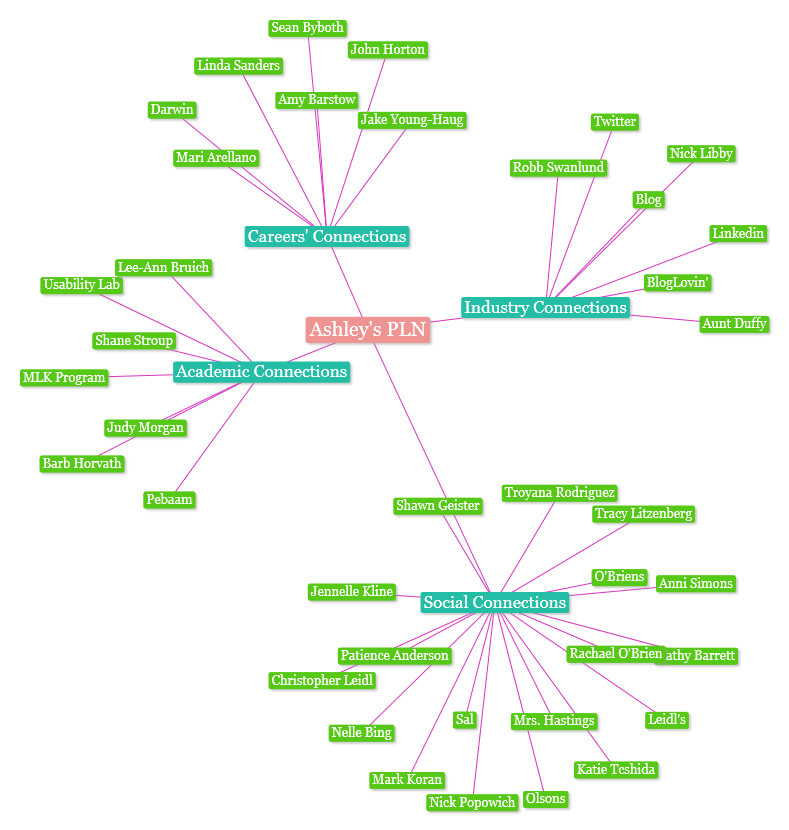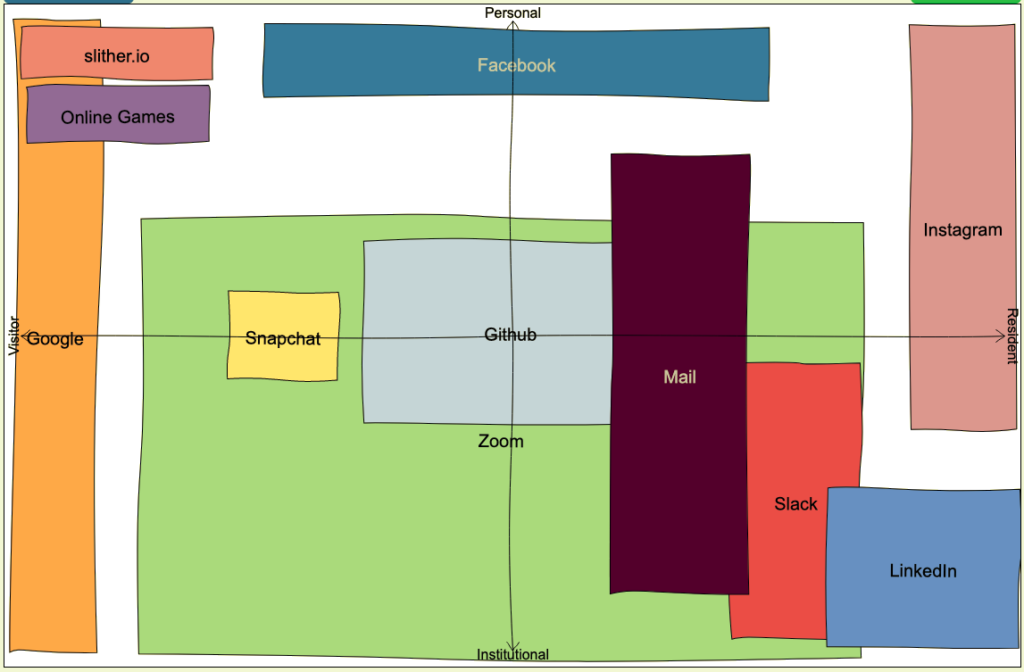- Examine the application of social media to support learning
Social media is a major part of our day to day life and there’s no point of keeping it away from educational purposes. Our major project for this course was to research and write about a social media platform. Not only did I learn about the insider knowledge of Snapchat, the social media platform my group and I worked on, but I also came to learn more about other social media platforms that could potentially support my learning.
For example, Xiaofeng’s group researched about LinkedIn where I read “LinkedIn does a good job of being inclusive as a job search social media.” I had never used LinkedIn before, however after reading up on their research, I decided to try it out myself and created an account. I was able to search for jobs and even internships where I could potentially apply to for my co-op semester this summer. Each social media platform has its own unique selling points and I believe there are educational purposes in each one of them.
————————————————————————————————————————— - Explain personalized learning and its relation to learning theory
The term personalized learning refers to a diverse variety of educational programs and academic-support strategies that are intended to address the distinct learning needs of individual students. Learning theory describes how students receive, process, and retain knowledge during learning. I believe that technology, as an educational tool, has reformed the traditional learning theories to offer a more personalized learning style for some individuals.
According to a literature review written by Atikah Shemshack and Jonathan Michael Spector, technology integration can play a crucial role to personalize the learning experience. The review talks about how “learning is a natural human activity that is shaped by personal experiences, opinions online, cultural background, and environment. Learning is formed through an individual’s interactions, including the conveyance of knowledge and skills from others on the internet.” To me, learning is a more of a personalized experience than a theory framework that allows one to expand their knowledge, perspective, skills, and understanding. Therefore, personalized learning models can help to meet individual needs and goals.
————————————————————————————————————————— - Recognize that the Internet is not a neutral or equal space for everyone
In the beginning, the Internet was supposed to be the great equalizer. A source of learning that would allow students in the poorest and most remote areas to have access to the same information that the most privileged children enjoyed. A way for small merchants to sell their goods to vast global markets. It was supposed to be a place to bring people together; people who never knew each other before. However, the internet kept growing with insecurities. Everything on the internet requires a policy to help maintain a civil online world.
While writing about Snapchat for our major project, I had to read through their private policies. We, as a user, usually overlook company policies because all we want to do is use the application for their separate purposes: Instagram to post pictures, Messenger to chat with friends, Tinder to find a relationship. Little did we know how much these companies know about us without us knowing. As written in our research, Snapchat had a recent privacy policy update where they collect log information such as details about how you’ve used their services, device information such as your web browser access times, pages viewed, IP address and pages you visited before or after navigating to our website. Sam Sheffer, a tech influencer, tweeted about this policy and freaked out as many would.
————————————————————————————————————————— - Apply social media to develop a personal learning network in support of your personal and/or professional development
Social media is a great way to build a PLN as it allows us to connect and share with other colleagues, friends and family. One of the main reasons I use different social medias is to build a well-rounded PLN that would benefit my personal and professional life. Different platforms allow us to connect with different people. For example, as I’ve elaborated on my own blog post, my high school friends are on Instagram, my family members are on Facebook and my colleagues/employers are on LinkedIn. Each platform is useful for their distinct purposes.
I had once created a facebook account for an HR company and requested to join a handful of HR groups. There was an HR Professionals group where we, the HR company I worked for, did business with other professionals. This proves that social media is a great way to create new networks with new people for personal and professional development.
————————————————————————————————————————— - Identify privacy issues and practice online behaviours that are legal, safe, consensual, and ethical
Social media users’ concerns about their privacy have spiked in recent years. Incidents of data breaches have alarmed many users and forced them to rethink their relationships to social media and the security of their personal information. Yet, we continue to use these social medias on a daily basis to stay in touch with current friends and family members, keep up with world news or even just to stay entertained.
Every major project group talked about how our information could potentially be used against us. Leo’s group talked about how Discord can read your private messages and delete specific content with no prior notice or without reason. Discord tracks users even if a user uses the Do Not Track (DNT) header. They can sell or transfer your personal data as part of a bankruptcy proceeding or other type of financial transaction. This is why we need to look out for our digital footprint and make sure to act wisely and ethically. Leo’s group ended that paragraph saying, “overall, by using Discord you relinquish your right to privacy regarding anything you say or do when using the service.”
————————————————————————————————————————— - Recognize data ownership and licensing (Creative Commons, Copyright, Fair Dealing, and Public Domain) as a core practice when creating, sharing, or using resources online
Copyright protects all original works, provided the conditions in the Copyright Act have been met. Through copyright, authors have the right to prevent others from reproducing their work or copying any substantial portion of it. This leads to the prevention of their work being copied to the degree where they cannot sell it effectively or receive credit for it. In this way, I believe that copyright is beneficial as it fosters intellectual creativity as it provides an incentive for a creator to work freely, allowing them to gain recognition for their work as well as protecting their livelihood.
Mary’s group project on Youtube described how Youtube deals with copyright infringements. When a creator is caught violating the rule, an algorithm runs to prevent the spread of the misinformation about largely discussed topics such as harmful conspiracy theories, hate speech, and recently incorrect medical information about COVID. Furthermore, they will receive a copyright strike and the video will be demonetised. Once a creator receives 3 copyright strikes, their Youtube channel will be terminated. This can be a big deal for some creators as they rely on youtube as their source of income. Therefore, serious Youtubers refrain from copying other creator’s content as it could negatively impact their personal lives.
I believe that copyright is a great system that indirectly forces intellectual and creative freedom, especially for social media content creators. If someone comes up with an original idea that works well, they will be rewarded through various means such as popularity, monetary and respect. The only constraint is that that the user must be aware of these copyright regulations before they create, share, or use resources online.
————————————————————————————————————————— - Practice digital, networked, and open literacies in support of learning about social media and personalized learning
Github provides a great platform for version control and collaboration. I have known about Github for many years, however this course was the first time I properly got to know how to use it. Professor Colin had initially created and invited everyone to a repository where we posted issues to introduce ourselves. This was the first time I had worked with Github and I thought I would break something. As I learned more about the various features of the platform, I grew curious about the other capabilities of Github.
At one point in the course, we were asked to make our own repositories where our learning pod collaborated on the major project. We were able to work on it together, simultaneously, without compromising the integrity of the original project. It was as simple as creating a group on Github like it was creating a group in any other social media. I was afraid that I could potentially delete the entire project with one misclick, however I came to realize there was a history section where I could see the past versions of our project. Github is one of the many platforms that allow a wide range of services which supports learning through personalised learning. As a computer science student, I’ve been told Github will be a crucial social networking site that I will be using on a daily basis and I look forward to it!
—————————————————————————————————————————
I’d like to thank Colin and all my peers for a wonderful semester. This course has not only been educational but also fun at the same time. I’ve gained a more vast idea about social media and learned some new skills along the way. I first encountered and started using Github four months ago, when the semester started. I was initially scared to use Github, thinking I would break something while learning how to use Github but luckily I didn’t. Now that I’ve got more comfortable using it in this course, I’d say I’m confident enough to explore the platform even more. Shoutout to Colin for the support when I was totally lost and confused on Github. Amazing course!



Recent Comments